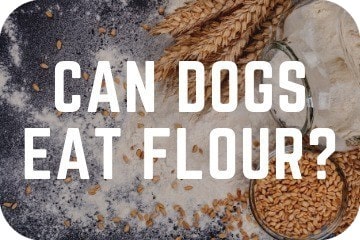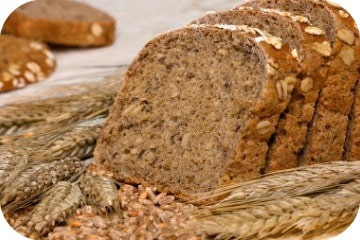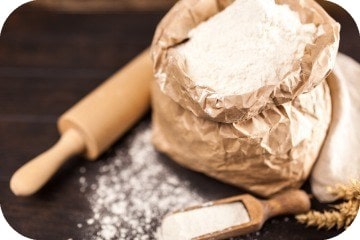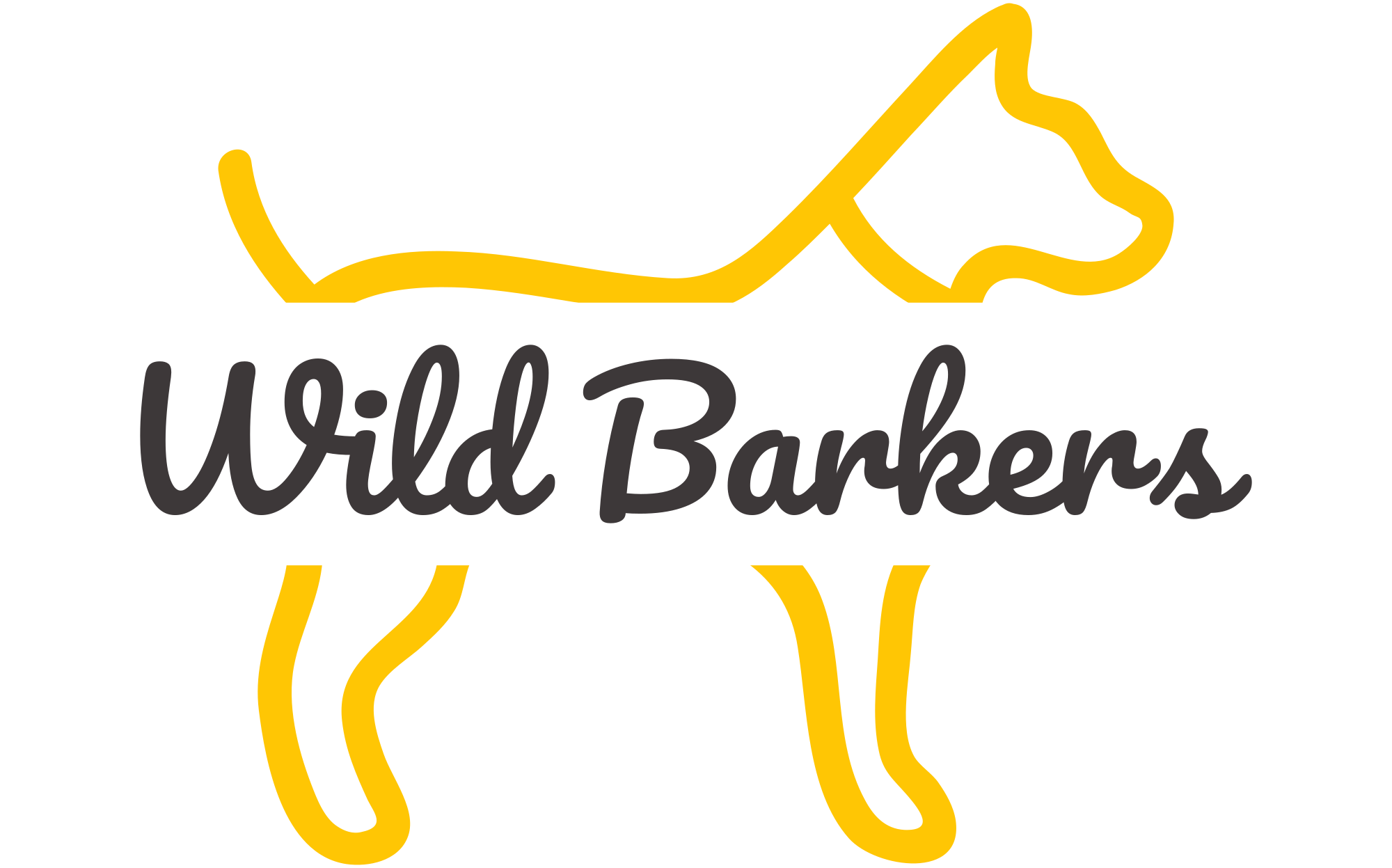
Can dogs eat flour? Yes, wheat flour is not toxic to dogs. However, it is common for dogs to have wheat, gluten, or grain allergies, which means traditional wheat flour would not be suitable.
There are many alternative options that can substitute traditional flour, for example, coconut flour, quinoa flour, rice flour, oat flour, among others, depending on the allergy or intolerance.
Flour is not a necessity in your dog’s diet, but it is commonly used in both their food and treats as a binding agent.
What if my dog ate a whole bag of flour?
Although not toxic, raw flour isn’t healthy for dogs.
Contact your veterinarian if your dog is displaying any unusual behavior, or you are concerned about the amount eaten.
Symptoms to look out for include:
- Excess salivating
- Vomiting or attempted by unable to vomit
- Diarrhea
- Constipation
- Nausea
- Pacing or restlessness
- Enlarged stomach
- Difficulty breathing
- Lethargy
- Fever
- Pale gums
If your dog has eaten a considerable amount of raw flour, it can cause a blockage. The texture will become gluey in their mouth and can cause an obstruction.
It has also been suggested that it could cause bloat, which could be life-threatening.
Busy? Get Your Hands Paws On The Answers Quickly…
3. Oat Flour
4. Almond Flour
6. Quinoa Flour
7. Chickpea (or garbanzo) Flour
8. Rice Flour
10. Corn Flour
SHOULD MY DOG BE GRAIN-FREE?

It depends. A healthy dog, with no allergies, should be able to process grains and reap the benefits.
Allergies are the main reason you should remove grains from your dogs’ diet.
Overall, there should be no reason to remove grains from your dogs’ diet unless they have an allergy or for another health reason recommended by your vet.
It is a good idea to switch up your dogs’ food regularly to prevent allergies from forming, and so they don’t become bored with their food. Everything should be given in moderation, and new food should be introduced slowly to avoid gastric upset.
Why are grain-free, gluten-free, low-carb diets so popular for dogs?
These diets are now common in the dog world. This is due to many reasons, the main ones being:
Dog Food Scandal – In 2007, wheat imported from China was contaminated with chemicals. This wheat was used by dog food companies, and sadly many dogs fell ill and died. Since then, many people have been avoiding wheat. However, it was not the wheat that caused the fatalities, but the chemicals.
Wolves – Many people think that because of their wild ancestors not needing or eating grains that their domestic dogs do not need grains in their diet either. However, dogs can digest different foods. Scientists think that when dogs evolved, they developed the ability to digest grains.
Keto, Atkins, Paleo Diets – Many people see or hear about the benefits of these diets and project this onto their dogs. The majority (up to 50%!) of dog food companies produce a no grain or gluten version to cater to this demand, despite very little evidence that it is superior.
Commercially produced grain-free dog food tends to contain carbohydrate alternatives, such as potatoes and legumes (beans, chickpeas, peas, lentils, etc.). This has been linked to a potential risk of Canine Dilated Cardiomyopathy DCM.
DCM is a common heart condition in dogs. It is when there is not enough pressure to pump the blood around the body. While DCM is not uncommon in dogs, it is more common in certain breeds. These are usually larger breeds, including Afghan Hounds, Saint Bernards, Newfoundlands, Great Danes, Irish Wolfhounds, etc.
Breeds not generally at high risk of DCM were being reported of suffering with it. The FDA is investigating a possible link between dogs who consumed a diet primarily made up of potatoes and legumes (including lentils, chickpeas, pulses, and other peas and beans) and acquiring DCM.
The FDA is still exploring this. Check this for more information and to keep up to date.
10 TYPES OF FLOUR AND THE RISKS AND BENEFITS TO DOGS

All of the flours below are safe for dogs in moderation.
Our Least Favorite Flours: White Wheat Flour and Corn Flour
Our Favorite Flours: Coconut Flour and Oat Flour
WHITE WHEAT FLOUR
(incl white, all-purpose, self-raising, bread, pasty, and cake flour)
Dog Safe
This is not the healthiest or most recommended variety of flour to use for dogs. Most white flours are bleached and heavily processed, which removes any potential benefits.
Cons:
Allergies – Wheat, gluten, and grains are some of the most common food allergens for dogs (and people). Allergies can be hard to detect, vets can do tests, but most people opt to experiment with different foods and observe the reactions.
Common signs of an allergy include:
- Itchiness
- Ear infections
- Hives
- Poor coat or skin condition
- Gastrointestinal Issues
If you confirm your dog suffers from specific food allergies, remove the food from their diet. Most brands offer a grain-free or gluten-free food option.
Little Nutritional Benefit – White flour is used as a baking and binding ingredient. It is usually heavily processed, which removes the majority of any nutrients. It has minimal health advantages for dogs (or humans). It is not required in a dogs’ diet and many healthier options could be used.
Digestive Issues – There is much controversy over whether dogs can digest wheat and starches. Many argue that due to their ancestors (wolves) being shown to consume predominately meat that dogs should follow the same diet. Although, scientists have shown that dogs are different. They have been shown to have adapted and developed the ability to digest grains when they were domesticated over 30,000 years ago.
Pros:
Easy To Bake With – If you are baking treats or biscuits for your dog, many people recommend using all-purpose flour. It is cheap, and most people already have it in their store cupboards.
Cheap – Many brands use wheat flour as it is affordable and works to bind ingredients together. It is a common additive to treats and dog food.
Source Of Energy – All-purpose flour contains around 76g carbohydrates per 100g. This helps provide energy for dogs and can reduce appetite.
WHOLE WHEAT, WHOLE GRAIN, OR WHOLEMEAL FLOUR
Dog Safe
The difference between white and whole wheat flour is that whole wheat utilizes the entire wheat berry. It is, therefore, more nutritious and beneficial for dogs. If your dog doesn’t have a wheat allergy, it is an affordable and easy to source carbohydrate. Many commercial dog food brands use wheat in their recipes.
Cons:
Allergies – Despite being more nutritiously dense than white flour, whole grain flour is still made from wheat, a common allergen for dogs.
If your dog is allergic to wheat, avoid feeding any product with wheat, or making food and cookies for your dog from it.
Pros:
Keeps Dogs Regular – With 13g of fiber per 100g, wheat is excellent for keeping your dog’s digestive system moving.
Muscle Health – Wholewheat contains around 10g protein per 100g; this can help contribute towards maintaining healthy muscles.
Easy To Source – Wheat flour is available in most food stores; it is affordable and easy to work into recipes.
OAT FLOUR
Dog safe, gluten-free, wheat-free
Oat flour is made by grinding oats into a powder. It is easy to make at home and affordable. It is a perfect alternative if your dog has wheat or gluten allergy. If you are looking for more information about oats, check out our post Can Dogs Have Oatmeal?
Cons:
Gastro-Intestinal Upset – New foods can cause diarrhea and vomiting. If you are introducing oats into your dogs’ diet for the first time, do so by gradually adding them into your dogs’ current food.
Pros:
Maintain A Healthy Coat – The vitamin B in oats helps keeps your dogs’ fur looking healthy.
May Help Lower Blood Pressure – Oats contain antioxidants, specifically avenanthramides. This is thought to help lower blood pressure and lead to better circulation.
Keep Your Dog Fuller For Longer – Being rich in carbohydrates, oats help your dog feel full quicker and for longer, without excess calories.
Reduce Constipation – With a considerable amount of fiber, oats will help keep your dog regular and stop constipation.
ALMOND FLOUR
Dog safe, grain-free, gluten-free, wheat-free
Almond flour is thought to be safe for dogs in small amounts. However, all nuts are high in fat and can cause gastric upset. We recommend only giving your dog a small amount of almond flour if any at all. If you’re interested in learning more about almonds and dogs, check out our article Can Dogs Have Almond Butter?
Cons:
High In Fat – All nuts contain a considerable amount of fat. This can cause obesity, pancreatitis, and other weight-related illnesses. High-fat food can also cause gastric upset in dogs.
Possible Toxins – Nuts that have grown mold or that are contaminated can be dangerous for dogs. They contain a toxin, Aspergillus flavus.
This toxin produces aflatoxin. Aflatoxin is present in many nuts, and although some levels are seemingly safe for humans, they can affect dogs differently.
The USDA does regulate the amount in nuts, but it is still unknown as to whether these could cause long term problems (link) (link).
Signs of aflatoxin poisoning include loss of appetite, lethargy, among others. A vet must be contacted if your dog displays any signs.
Allergies – Nut allergies are common among humans and dogs. Unfortunately, if your dog has a nut allergy, you will have to avoid almond flour.
Signs of an allergy include:
- Sneezing
- Watery Eyes and Nose
- Puffiness
- Swelling
- Itching
Pros:
Keep Immune System Healthy – There is an abundance of vitamin E in almonds; this helps to keep a dogs’ immune system functioning correctly.
Keeps Muscles Strong – Almonds contain a considerable amount of protein. Protein helps maintain bone strength, keep the skin and coat healthy, as well as keeping the muscles strong.
COCONUT FLOUR
Dog safe, grain-free, gluten-free, wheat-free
Coconut flour is considered one of the most healthy options for making dog treats and has a whole host of benefits. It is made by baking the pulp of the coconut before blending into a powder consistency. It is incredibly absorbent and requires far more liquid in the recipe compared to wheat or almond flour.
Cons:
Can Be Challenging To Work With – Due to its absorbency, coconut flour can require a considerable amount more liquid. It can be a challenge to work it and usually produces a denser, claggier type cookie.
Expensive – Coconut flour can be more difficult to source. It usually comes with a high price tag compared to traditional baking flours too.
Pros:
Helps Control Blood Sugar – Many flours cause blood sugar to spike due to the number of carbohydrates. Coconut flour is low in carbohydrates, which helps with sugar and insulin regulation.
High in Protein – Coconut flour is an excellent source of plant-based protein. This helps keep bones, muscles, and the immune system healthy.
QUINOA FLOUR
Dog safe, grain-free, gluten-free, wheat-free
Quinoa is prepared, eaten, and has a similar nutritional profile to a grain. However, it is not a grain. It is a seed. It comes in a variety of colors and is considered to be a healthy addition to your dogs’ diet. Quinoa flour is prepared by rinsing the seeds, toasting them, and blending them into a flour. For more information check out our post on Can Dogs Have Quinoa?
Cons:
Potential Toxins – Saponin is a naturally occurring toxin that quinoa produces. It is what gives quinoa a slightly bitter taste. It is produced to deter bugs and other animals from eating it while it is growing. It is thought to cause intestinal damage and inflammation. Dogs can be more sensitive to saponin than humans. Make sure to rinse and cook the quinoa to minimize any risk.
Pros:
Weight Loss – Quinoa is great at reducing appetite as it is high in carbohydrates and protein. This will help keep your dog fuller for longer.
Gluten-Free – If your dog is sensitive to gluten or grains, quinoa flour is a good alternative. It is naturally free of both and has more health benefits compared to potatoes.
CHICKPEA (OR GARBANZO) FLOUR
Dog safe, grain-free, gluten-free, wheat-free
Chickpeas are safe for dogs in moderation. They contain a considerable amount of carbohydrates, protein, and fiber. If you want more information, check out our post on Is Hummus Safe For Dogs?
Cons:
Difficult to the source – Chickpea flour is not always easy to find in the grocery store, you may have to make your own or visit a health food store.
Pros:
May Help With Losing Weight – Chickpeas are relatively low in calories and fat but packed with fiber. Snacking on chickpeas should keep your dog fuller for longer, thus aiding in weight loss.
Prevent Constipation – The fiber in chickpeas will help keep your dog regular. This will help prevent constipation and aid in anal gland expression.
High Source Of Meat-Free Protein – If your dog is on a vegetarian or vegan diet (for health reasons, or as approved by a nutritionist or veterinarian), chickpeas can be a great source of protein. Protein helps maintain healthy muscles for your dog.
Linked To Helping With Some Conditions – Chickpeas contain vitamins and minerals thought to help with chronic conditions like cancer, diabetes, and heart disease in humans, there is no reason to believe these cannot be translated to our canines (link) (link).
RICE FLOUR
Dog safe, gluten-free, wheat-free
Rice flour is another great alternative to wheat for dogs with allergies. Rice flour is easy to make (simply blend the rice grains in the food processor until flour forms), readily available, and cheap.
Cons:
Little Nutritional Benefits – White rice particularly has little nutritional benefits.
Can Be Challenging To Work With – Rice is starchy, this can leave the dough overly sticky and difficult to work with.
Pros:
Easy and Cheap – Most people have a packet of rice in the pantry; it is easy and cheap to find for your dog.
Provide Energy – Rice is rich in carbohydrates, which help provide dogs with ample energy for the day.
Helps With Gastric Issues – If your has had a bout of diarrhea and/or vomiting, rice is great at clearing out their digestive tract and easing them back into eating properly. It is easy for your dog to digest and is commonly prescribed with white fish or chicken after a runny tummy.
BUCKWHEAT FLOUR
Dog safe, grain-free, gluten-free, wheat-free
Once cooked, the buckwheat seeds are a healthy addition to your dogs’ diet. The greens are toxic, so make sure that you are only feeding your dog the cooked seeds.
Cons:
Expensive – Compared to wheat and corn flour, buckwheat is more costly and sometimes difficult to find in regular grocery stores.
Pros:
Safer For Diabetic Dogs – Buckwheat releases its carbohydrate slowly compared to wheat. This means it provides your dog with a steady stream of energy and reduces sugar spikes and may improve insulin resistance. This is beneficial to help manage diabetes.
May Help Prevent Cancer – Buckwheat contains antioxidants. Antioxidants protect your cells from free radicals, which can be harmful and cause inflammation. Inflammation can be a contributor to cancer (link).
CORN FLOUR
Dog safe, gluten-free, wheat-free
Corn flour is made by grinding down whole corn kernels. It is usually yellow in color. It is commonly added to dog food to help bind it together. It has little nutritional value and can be difficult to digest but is cheap to source.
Cons:
Low In Nutrients – Corn flour isn’t thought to have many nutritional benefits for dogs. It is usually used as a filler food or binding agent in kibble.
Pros:
Cheap – Corn flour is cheap. It is easy to use in dog food recipes.
5 DOG TREAT RECIPES WITH FLOUR
Our Easy, Nutty Dog Treats, check out the full post here
Ingredients:
- 1 carrot
- 1 egg
- 1/4 cup peanut butter
- 1 cup almond flour
Directions:
1. Preheat the oven to 350 degrees F (176 degrees C) and line a baking sheet with parchment paper.
2. Shred the carrot into a bowl.
3. Add the egg and mix.
4. Add the flour and combine.
5. Stir in the peanut butter and mix until it forms a ball.
6. Use a tablespoon to scoop out the mixture. Roll between your hands to form a ball.
7. Use the back of a fork to flatten the treats.
8. Bake for 20-25 minutes or until golden. Allow to cool before serving to your furry friend.
Tuna and Cheese Dog Treats, inspired by Mccan Dogs
Ingredients:
- 1 can of tuna
- 1 cup whole wheat flour
- 1/4 cup cheese
- 1 egg
Directions:
1. Preheat the oven to 350 degrees F (176 degrees C) and line a baking pan with parchment paper.
2. Combine all of the ingredients in a bowl until it forms a paste.
3. Press the mixture into the pan and bake for 20 minutes.
4. After the 20 minutes, remove from the pan and cut into treat sized pieces.
5. Lower the temperature to 275 degrees F (135 degrees C).
6. Place back on the baking pan and cook for a further 40-60 minutes.
7. Remove from the oven, break down further if required.
8. Allow to cool before serving to your dog.
Classic Dog Treats, inspired by The Blond Cook
Ingredients:
- 3 cups whole wheat flour + extra for rolling
- 2 large eggs
- 1/3 cup water
Directions:
1. Preheat the oven to 350 degrees F (176 degrees C).
2. Combine all the ingredients in a bowl to form a firm dough.
3. Roll out the dough to 1/4-inch thick with a rolling pin, using extra flour to prevent sticking.
4. Cut into treat sized biscuits.
5. Bake for 15-20 minutes or until slightly browned.
6. Allow to cool before serving.
Peanut Butter and Parsley Dog Treats, inspired by King Arthur Flour
Ingredients:
- 2 cups whole wheat flour
- 1 cup oats
- 1 tbsp parsley
- 2 eggs
- 1/2 cup milk (or dog-safe dairy alternative)
- 1 cup 100% peanut butter
- 1/2 cup cold water
Directions:
1. Preheat the oven to 300 degrees F (148 degrees C) and line a baking sheet with parchment paper.
2. Combine the dry ingredients.
3. Add the eggs and peanut butter and mix.
4. Add the water slowly until a dough forms.
5. Roll out to a 1/4-inch thick and cut into treat sized biscuits.
6. Bake for 40-60 minutes (depending on the size of the treats) or until golden brown and crisp.
7. Allow to cool before serving.
Banana and Peanut Butter Dog Treats, Inspired by Flora and Vino
Ingredients:
- 1 1/2 cups oat flour (or blended oats)
- 1/2 cup 100% peanut butter
- 1 large ripe banana
Directions:
1. Preheat the oven to 350 degrees F (176 degrees C) and line a baking sheet with parchment paper.
2. Combine the peanut butter and banana in a bowl.
3. Add the oat flour until it forms a dough. If it’s too crumbly, add 1-2 tbsp water.
4. Scoop a treat sized amount and roll in your hands to form a ball.
5. Place on the baking sheet and flatten with the back of a fork.
6. Bake for 15 minutes, or until set.
7. Allow to cool before serving.
FAQS
Are dogs allergic to flour?
They can be. Wheat or grains are a common allergen for dogs. Dogs can also be gluten intolerant, which includes wheat flour.
What happens if a dog eats flour?
Flour is safe for dogs in moderation, so your dog should be fine after consuming flour, providing they do not have gluten, wheat, or grain allergies.
SaveWe’re here to give you all the best tips, tricks, and information for your dog or puppy. Including, training, playing, feeding, and of course loving and caring!Published byWild Barkers
Looking for more pawsome posts? Check these out…
Frozen Muffin Enrichment Activity
How To Make A Snuffle Mat
When Do Puppies Lose Their Teeth?
Natural DIY Dog Treats
Kong Stuffing Ideas
Disclaimer: Each dog is different, and every circumstance is different. All efforts have been made to provide accurate information. However, it is not provided by a qualified Veterinarian, Veterinarian Surgeon, or Behaviorist. The information provided is purely educational. The information should not be used as an alternative or substitute for medical care. If you have any health or medical concerns, contact a qualified Veterinary Surgeon or Veterinarian immediately.










No Comment! Be the first one.